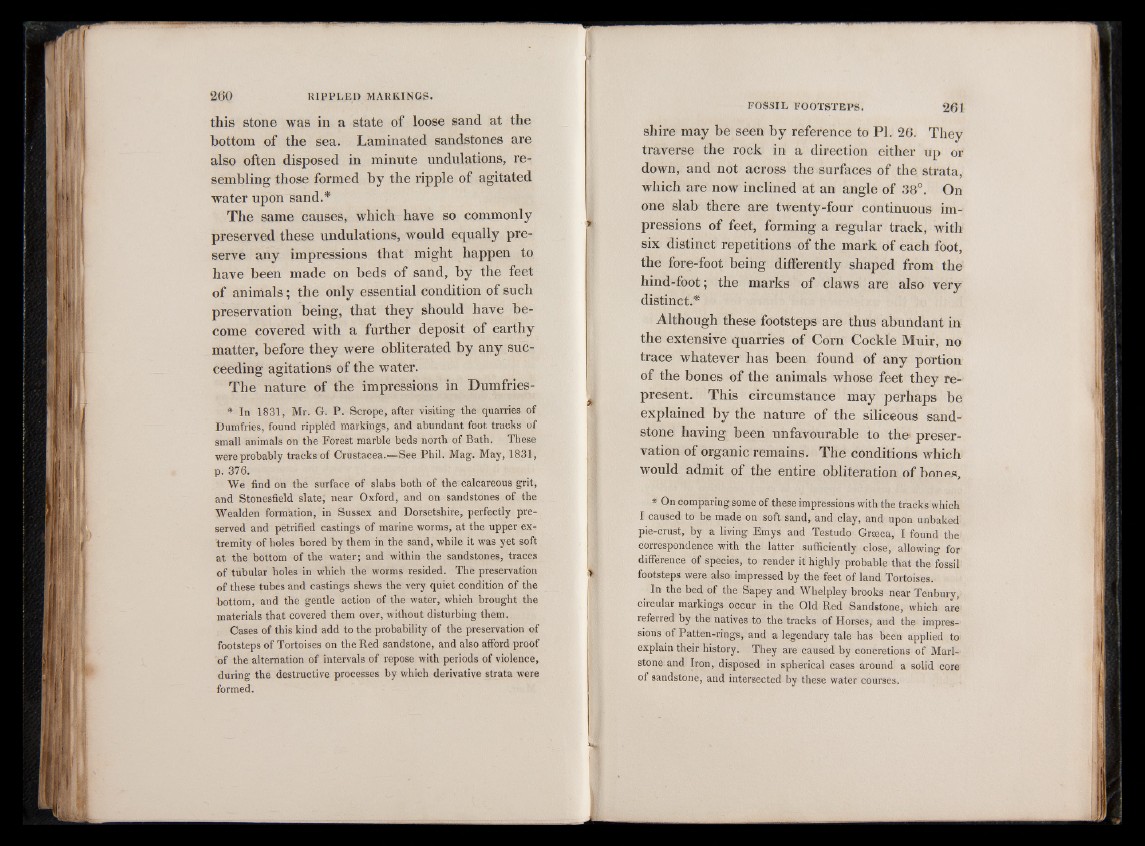
this stone was in a state of loose sand at the
bottom of the sea. Laminated sandstones are
also often disposed in minute undulations, resembling
those formed by the ripple of agitated
water upon sand.*
The same causes, which have so commonly
preserved these undulations, would equally preserve
any impressions that might happen to
have been made on beds of sand, by the feet
of animals; the only essential condition of such
preservation being, that they should have become
covered with a further deposit of earthy
matter, before they were obliterated by any succeeding
agitations of the water.
The nature of the impressions in Dumfries-
* In 1831, Mr. G. P. Scrope, after visiting the quarries of
Dumfries, found rippled markings, and abundant foot tracks of
small animals on the Forest marble beds north of Bath. These
were probably tracks of Crustacea.—See Phil. Mag. May, 1831,
p. 376.
We find on the surface of slabs both of the calcareous grit,
and Stonesfield slate, near Oxford, and on sandstones of the
Wealden formation, in Sussex and Dorsetshire, perfectly preserved
and petrified castings of marine worms, at the upper extremity
of holes bored by them in the sand, while it was yet soft
at the bottom of the water; and within the sandstones, traces
of tubular holes in which the worms resided. The preservation
of these tubes and castings shews the very quiet condition of the
bottom, and the gentle action of the water, which brought the
materials that covered them over, without disturbing them.
Cases of this kind add to the probability of the preservation of
footsteps of Tortoises on the Red sandstone, and also afford proof
of the alternation of intervals of repose with periods of violence,
during the destructive processes by which derivative strata were
formed.
FOSSIL FOOTSTEPS. 261
shire may be seen by reference to PI. 26. They
traverse the rock in a direction either up or
down, and not across the surfaces of the strata,
which are now inclined at an angle of 38°. On
one slab there are twenty-four continuous impressions
of feet, forming a regular track, with
six distinct repetitions of the mark of each foot,
the fore-foot being differently shaped from the
hind-foot; the marks of claws are also very
distinct.*
Although these footsteps are thus abundant in
the extensive quarries of Corn Cockle Muir, no
trace whatever has been found of any portion
of the bones of the animals whose feet they represent.
This circumstance may perhaps be
explained by the nature of the siliceous sandstone
having been unfavourable to the preservation
of organic remains. The conditions which
would admit of the entire obliteration of bones,
* On comparing some of these impressions with the tracks which
I caused to be made on soft sand, and clay, and upon unbaked
pie-crust, by a living Emys and Testudo Grseca, I found the
correspondence with the latter sufficiently close, allowing for
difference of species, to render it highly probable that the fossil
footsteps were also impressed by the feet of land Tortoises.
In the bed of the Sapey and Wlielpley brooks near Tenbury,
circular markings occur in the Old Red Sandstone, which are
referred by the natives to the tracks of Horses, and the impressions
of Patten-rings, and a legendary tale has been applied to
explain their history. They are caused by concretions of Marl-
stone and Iron, disposed in spherical cases around a solid core
of sandstone, and intersected by these water courses.